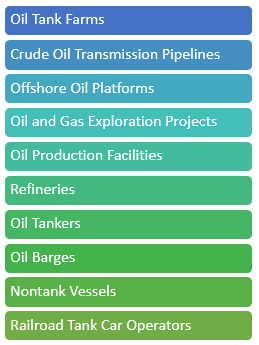Contingency Plan - Frequently Asked Questions
- What is an oil discharge prevention and contingency plan?
 A contingency plan ensures that the plan holder has measures in place to prevent and respond to oil spills, thereby reducing the impact to public health and the environment. A contingency plan provides enough information to guide personnel during an emergency event to respond to a discharge of any size. In order to effectively do so, the plan must contain: emergency action procedures, facility diagrams, preventative programs including training programs and substance abuse monitoring, descriptions of oil transfer and storage procedures, an incident command system, response limitations, logistical support, available equipment and proof of best available technology use. Simply put, a contingency plan clearly identifies the who, what, when, where, and how for preventing and responding to oil spills. For more information, please see AS 46.04.030; AS 46.04.055; 18 AAC 75.400
A contingency plan ensures that the plan holder has measures in place to prevent and respond to oil spills, thereby reducing the impact to public health and the environment. A contingency plan provides enough information to guide personnel during an emergency event to respond to a discharge of any size. In order to effectively do so, the plan must contain: emergency action procedures, facility diagrams, preventative programs including training programs and substance abuse monitoring, descriptions of oil transfer and storage procedures, an incident command system, response limitations, logistical support, available equipment and proof of best available technology use. Simply put, a contingency plan clearly identifies the who, what, when, where, and how for preventing and responding to oil spills. For more information, please see AS 46.04.030; AS 46.04.055; 18 AAC 75.400- Does my facility need a contingency plan?
- The State of Alaska requires an approved oil discharge prevention and contingency plan for certain facilities. Below is a general list of facilities that require an approved plan. For more information, please see AS 46.04.030; AS 46.04.055, 18 AAC 75.400 and Do I Need a Contingency Plan?

- What is a nontank vessel?
- A nontank vessel is a self-propelled watercraft of more than 400 gross registered tons.* Examples include: commercial fishing vessels, commercial fish processing vessels, passenger vessels and cargo vessels, but does not include a tank vessel, oil barge or public vessel. For more information on nontank vessels, please see AS 46.04.900(11).
*Alaska uses the USCG definition at 33 CFR 138.30 for gross tonnage.
- What if I intend to bring a tank vessel or oil barge, not listed in my plan, into State waters temporarily?
- A spot charter is a single voyage entry into Alaskan waters for the purpose of transporting oil or petroleum products in bulk by a vessel that is temporarily added to an existing contingency plan by amendment. The spot charter amendment must be approved by DEC prior to the vessel entering State waters. Each time a plan holder intends to bring a spot charter vessel into State waters, the plan holder must submit an application for amendment that includes a spot charter information packet which references the approved contingency plan and supplies additional vessel specific information. At a minimum, the spot charter information packet must include the items listed in the Spot Charter Checklist. For more information on spot charter amendments, please see 18 AAC 75.415.
- I already have a federal contingency plan. Do I also need one for the State?
- Yes. The Federal and State governments have separate regulations for oil discharge prevention and contingency plans. One plan may be developed containing regulatory components of both governments and submitted to both state and federal regulatory agencies to meet applicable regulations. For more information on state requirements for an oil discharge prevention and contingency plan, please see AS 46.04.030; AS 46.04.055, 18 AAC 75.400; 18 AAC 75.425.
- Is there an example of a contingency plan that I can review and copy?
- DEC does not have sample plans available for use. A plan application (PDF 185K) and a plan guidance document are available on the DEC website to assist with the preparation of a plan. The plan holder must schedule a pre-application consultation meeting with DEC. During the meeting, some of the topics that may be covered are: the plan holder’s obligations, facility or regionally specific requirements, plan contents and approval criteria, and public review process. For more information on oil discharge prevention and contingency plan content requirements, please see 18 AAC 75.425 and Apply for a Contingency Plan.
- When and how do I make an amendment to my plan?
- A plan holder must apply for a plan amendment any time changes need to be made to a plan, regardless of how minor the changes may be. It is up to the plan holder to ensure that the plan continuously complies with state regulatory requirements and the plan holder can meet plan commitments. Amendments can include adding new regions of operation and updating notification lists to amending response capabilities as primary response action contractors revise their own response capabilities. To make an amendment, the plan holder must submit an amendment application package. Once DEC receives the amendment application package, the package will be evaluated to determine if the amendment is a routine update, or minor or major amendment. If it is a routine update or minor amendment, DEC can approve it without a public comment period. If it is a major amendment the review procedures under 18 AAC 75.455, which contains a public review period, are followed. For more information on plan amendments, please see 18 AAC 75.415; and Apply for a Contingency Plan.
- How long does it take to get a plan amendment approved?

- How long is a streamlined vessel plan valid for?
- Plan approvals are generally valid for 5 years; however, nontank vessels may suspend or terminate a plan prior to that time. It is the plan holder's responsibility to check the approval status of existing plans prior to arriving in State waters. For more information on nontank vessel plans, please see 18 AAC 75.421 and 18 AAC 75.456.
- When do I renew my contingency plan?
- An application package must be submitted at least 180 days, or the number of days stated in the plan approval letter, in advance of the expiration of the plan. Plans are generally approved for 5 years. The same application is used for renewing a plan as for applying for a plan. For more information on plan renewals, please see 18 AAC 75.420 and Apply for a Contingency Plan.
- What is an oil spill Primary Response Action Contractor (PRAC)?
- A PRAC is an organization registered with the State of Alaska that is obligated under a contractual relationship with a contingency plan holder to provide personnel and/or equipment to contain, control, or clean up oil spills for the plan holder. A PRAC may be under contract to multiple plan holders, please see 18 AAC 75.500.
- As a plan holder, do I need to contract with a PRAC?
- A plan holder must either maintain on their own, or have available under contract, the resources to clean up a spill. A contract with a PRAC, who has the resources available to meet the cleanup needs of the plan holder, can meet this requirement, please see AS 46.04.030(k) AS 46.04.055(j). If the contract status with your PRAC changes or your PRAC changes, you must notify DEC.
- As a streamlined plan holder, do I need to hire contractors?
- An operator must contract cleanup and incident management services for the plan and may hire a Response Planning Facilitator (RPF) to secure response contracts, prepare the plan application and submit it for approval. Here is the list of registered nontank contractors.
- How do I locate a PRAC that is registered with the State of Alaska?
- The State of Alaska maintains a list of approved Primary Response Action Contractors that can be found at Primary Response Action Contractors.
- What is the requirement for an Alaska Certificate of Financial Responsibility?
- A Certificate of Financial Responsibility (COFR) is issued to a plan holder when the plan holder has provided to the Department of Environmental Conservation, and the Department has approved, proof of ability to financially respond in damages. For more information on financial requirements, please see AS 46.04.040, AS 46.04.055 and Financial Responsibility and Prevention Initiatives.
- What are the penalties for not having a contingency plan?
- Operation of a facility in the State without an approved contingency plan is a violation of Alaska statutes and regulations and may subject the owner/operator to civil liability for damages and to civil and criminal penalties. Civil and criminal sanctions may also be imposed for any violation of AS 46.04.010, et. seq., any regulation issued there under or any violation of a lawful order of DEC. The exact penalties imposed, if any, will depend on the nature of the violation. For more information on penalties and sanctions, please see 18 AAC 75.490; AS 46.03.760.
- Why does DEC conduct inspections?
- DEC conducts announced and unannounced inspections of facilities that require a contingency plan. Inspections are performed to ensure that the plan holder is in compliance with their plan. Response equipment inspections are conducted to ensure that the essential equipment listed on in the plan is response ready and capable of being used as intended in a response. DEC can conduct inspections as often as it deems necessary to ensure compliance with oil spill regulations and contingency plans. Following an inspection, if issues are identified, DEC will work with the plan holder to resolve them. Serious problems could result in a Notice of Violation or other corrective action(s) under 18 AAC 75.490. For more information on inspections, please see 18 AAC 75.480.
- Why does DEC conduct discharge exercises (drills)?
- DEC may conduct announced or unannounced discharge exercises with any plan holder twice a year to verify the plan holder's ability to carry out the spill prevention and response strategies described in the contingency plan. If problems are identified, DEC may choose to conduct additional discharge exercises. Any or all aspects of a contingency plan may be verified during a discharge exercise. Discharge exercises may range from focused table-top exercises to large-scale equipment deployments. Following a discharge exercise, if issues are identified, DEC will work with the plan holder to resolve them. For more information on drills, please see 18 AAC 75.485 and Spill Response Exercise Improvements.

 Indicates an external site.
Indicates an external site.